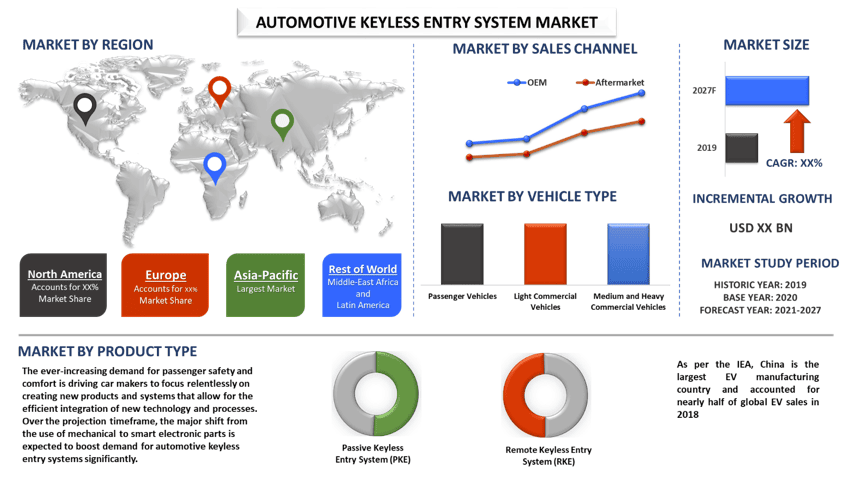- Home
- About Us
- Industry
- Services
- Reading
- Contact Us
Automotive Keyless Entry System Market: Current Analysis and Forecast (2021-2027)
Emphasis on Product Type (Passive Keyless Entry System (PKE) and Remote Keyless Entry System (RKE)); Vehicle Type (Passenger Vehicle, Light Commercial Vehicle, and Medium & Heavy Commercial Vehicles); Sales Channel (OEM and Aftermarket); and Regions/Country

Automotive Keyless Entry System Market is anticipated display a CAGR of around 8% over the forecast period (2021-2027). The keyless entry feature allows vehicle owners to lock and unlock their vehicle without physically using the key. They can lock the vehicle by walking away with the key and it will unlock once the key is in close proximity. The key can be set to unlock one door, multiple doors, or even the trunk on entry. Global automotive keyless entry system market is majorly driven by the steady growth in the vehicle sales with the overall demand for the advance electric systems. Autonomous driving (AD), connected cars, and electrification of powertrain are the major trends that are mutually reinforcing developments in the automotive industry. All these trends are not only disrupting the automotive value chain and affecting all stakeholders but also are major drivers for the market. Furthermore, rising adoption of electric vehicles in also driving the demand for automotive keyless entry system.
Insights Presented in the Report
“Amongst Product Type, RKE system category dominated the market in 2020”
Based on product type, the market is bifurcated into Passive Keyless Entry System (PKE) and Remote Keyless Entry System (RKE). In 2020, RKE system to hold majority share owing to larger penetration and easy availability of these systems. However, PKE systems to witness fastest growth of XX% during the forecast period. This is mainly due to the its benefits by conferring the added conveniences of opening doors, enabling users to start the engine wthout taking the key fob out of the pocket, and allowing the storage of vehicle settings data and remote opening of windows. This has resulted in higher adoption rate and integration of PKE systems in vehicles by OEMs as a vale added feature. Furthermore, Automotive keyless entry system manufacturers are actively focusing on design innovations, opening new opportunities for the market. Furthermore, automakers are introducing smart key systems that employ radio communications and advanced detection systems to detect the presence of the key fob near or inside the vehicle..
“Amongst Vehicle Type, Light Commercial Vehicle category to witness fastest growth during the forecast period”
Based on vehicle type, the market is segmented into passenger vehicle, light commercial vehicle, and medium & heavy commercial vehicles.. Light commercial vehicle category is expected to witness highest CAGR of during the forecast period owing to sustained economic activities coupled with increasing e-commerce activities, have bolstered the growth of the light commercial vehicle market. Furthermore, market players are investing heavily on the research and launch of advance systems for commercial vehicles, which is further expected to drive the market. For instance, in 2018, Valeo S.A. displayed its innovative fleet management solution: Mov’InBlue at IAA International Motor Show for commercial vehicles (IAA CV 2018). The company has developed Mov’InBlue, a smart fleet management solution compatible with more than 95% of vehicles on the road that allows users to lock and unlock their vehicle and start the engine from their smartphone using a secure digital key..
“Amongst Sales Channel, OEM category dominated the market”
Based on sales channel, the market is bifurcated into OEM and aftermarket. Among these, OEM category to hold the majority during the forecast period. This is mainly due to the increasing number of vehicle theft incidents, driving the demand for advanced security features like keyless entry systems. Vehicle theft instances have grown significantly across the world. For instance, according to the National Insurance Crime Bureau, US$ 6 Billion was lost due to vehicle thefts in the US. Therefore, OEMs are adding new features like stolen vehicle assist and smart keyless entry systems for better vehicle safety and security. Thus, keyless entry system for cars came with innovation and this is what attracted a large number of buyers, resulting increased demand for OEM integrated keyless entry system in vehicles. All major vehicle manufacturers offers smart keyless entry systems. For instance, Smart Key Fob, which is available with Honda vehicles, car owners do not even have to push a button. Once they put their hand in the door handle, with the key fob in their pocket or purse, the car will automatically unlock the doors.
“Asia-Pacific is expected to witness highest growth during the forecast period”
For a better understanding of the demand of Automotive Keyless Entry System, the market is analyzed for major regions including North America (US, Canada, Rest of North America); Europe (Germany, UK, France, Italy, Rest of Europe); Asia-Pacific (China, Japan, South Korea, Rest of Asia-Pacific); and Rest of World. Currently, Asia-Pacific dominates the market. Moreover, it is expected to grow with considerable CAGR during the forecast period owing to growing awareness and demand for new-age electric vehicles coupled with presence of large number of automotive OEMs and component manufacturers in countries like India and China. China is the largest automobile market in the world whereas India is the fifth largest automobile market in the world, surpassing Germany in terms of sales, as of 2020. Furthermore, the demand for smart keys in the Chinese, as well as the Indian market, is growing rapidly, as various Chinese and Indian companies are launching vehicles with keyless entry features, which shall lead to a growth of the automotive smart key market in China and India. For instance, Tata Nexon is a 5-seater SUV. One of the many features that add to the comfort and convenience of the driving experience is the Smart key feature. The press of the button on the door handle of the Nexon with the key fob inside the pocket and car owners can gain entry into the vehicle.
Reasons to buy this report:
- The study includes market sizing and forecasting analysis validated by authenticated key industry experts
- The report presents a quick review of overall industry performance at one glance
- The report covers an in-depth analysis of prominent industry peers with a primary focus on key business financials, product portfolio, expansion strategies, and recent developments
- Detailed examination of drivers, restraints, key trends, and opportunities prevailing in the industry
- The study comprehensively covers the market across different segments
- Deep dive regional level analysis of the industry
Customization Options:
The Automotive Keyless Entry System Market can further be customized as per the requirement or any other market segment. Besides this, UMI understands that you may have your own business needs, hence feel free to connect with us to get a report that completely suits your requirements.
Table of Content
Analyzing the historical market, estimation of the current market, and forecasting the future of the Automotive Keyless Entry System Market were the three major steps undertaken to create and analyze the demand and sales of Keyless Entry System across automotive sector globally. Exhaustive secondary research was conducted to collect the historical market numbers and estimate the current market size. Secondly, to validate these insights, numerous findings and assumptions were taken into consideration. Moreover, exhaustive primary interviews were conducted, with industry experts across the value chain of the industry. Post assumption and validation of market numbers through primary interviews, we employed a bottom-up approach to forecast the complete market size. Thereafter, market breakdown and data triangulation methods were adopted to estimate and analyze the market size of segments and sub-segments the industry pertains to. Detailed methodology is explained below.
Analysis of Historical Market Size
Step 1: In-Depth Study of Secondary Sources:
Detailed secondary study was conducted to obtain the historical market size of the Automotive Keyless Entry System through company internal sources such as annual report & financial statements, performance presentations, press releases, etc., and external sources including journals, news & articles, government publications, competitor publications, sector reports, third-party database, and other credible publications.
Step 2: Market Segmentation:
After obtaining the historical market size of the Automotive Keyless Entry System, we conducted a detailed secondary analysis to gather historical market insights and share for different segments & sub-segments for major regions. Major segments included in the report are product type, vehicle type, and sales channel. Further regional level analyses were conducted to evaluate the overall demand of Automotive Keyless Entry System in global context.
Step 3: Factor Analysis:
After acquiring the historical market size of different segments and sub-segments, we conducted a detailed factor analysis to estimate the current market size. Further, we conducted factor analysis using dependent and independent variables such as growing demand for premium and electric vehicle and technological advancement in the automotive sector etc. Historical trends and their year-on-year impact on the market size and share was analyzed. Demand and supply side scenario was also thoroughly studied.
Current Market Size Estimate & Forecast
Current Market Sizing: Based on actionable insights from the above 3 steps, we arrived at the current market size, key players in the Market, and market shares of the segments and company. All the required percentage split, and market breakdowns were determined using the above-mentioned secondary approach and were verified through primary interviews.
Estimation & Forecasting: For market estimation and forecast, weights were assigned to different factors including drivers & trends, restraints, and opportunities available for the stakeholders. After analyzing these factors, relevant forecasting techniques i.e., bottom-up approach was applied to arrive at the market forecast to 2027 for different segments and subsegments across the major regions globally. The research methodology adopted to estimate the market size encompasses:
- The industry’s market size, in terms of value (US$) and the demand of Automotive Keyless Entry System across the major regions globally
- All percentage shares, splits, and breakdowns of market segments and sub-segments
- Key players in the Automotive Keyless Entry System Market in terms of products offered. Also, the growth strategies adopted by these players to compete in the fast-growing market.
Market Size and Share Validation
Primary Research: In-depth interviews were conducted with the Key Opinion Leaders (KOLs) including Top Level Executives (CXO/VPs, Sales Head, Marketing Head, Operational Head, and Regional Head, Country Head, etc.) across major countries. Primary research findings were then summarized, and statistical analysis was performed to prove the stated hypothesis. Inputs from primary research were consolidated with secondary findings, hence turning information into actionable insights.
Split of Primary Participants in Different Regions

Market Engineering
Data triangulation technique was employed to complete the overall market estimation and to arrive at precise statistical numbers of each segment and sub-segment of the Automotive Keyless Entry System market. Data was split into several segments & sub-segments post studying various parameters and trends in the areas of product type, vehicle type, sales channel, and region.
The main objective of the Automotive Keyless Entry System Market Study
The current & future market trends of the Automotive Keyless Entry System Market are pinpointed in the study. Investors can gain strategic insights to base their discretion for investments from the qualitative and quantitative analysis performed in the study. Current and future market trends would determine the overall attractiveness of the market at a regional level, providing a platform for the industrial participant to exploit the untapped market to benefit as a first-mover advantage. Other quantitative goals of the studies include:
- Analyze the current and forecast market size of Automotive Keyless Entry System in terms of value (USD). Also, analyze the current and forecast market size of different segments and sub-segments of the industry
- Segments in the study include product type, vehicle type, sales channel, and Regions
- Defined analysis of the regulatory framework for the Automotive Keyless Entry System industry
- Analyze the value chain involved with the presence of various intermediaries, along with analyzing customer and competitor behaviors pertaining to the industry
- Major regions analyzed in the report include North America (US, Canada, Rest of North America); Europe (Germany, UK, France, Italy, Rest of Europe); Asia-Pacific (China, Japan, South Korea, Rest of Asia-Pacific); and Rest of World. Define and analyze the competitive landscape of the Automotive Keyless Entry System sector and the growth strategies adopted by the market players to sustain in the fast-growing market
- Deep dive regional level analysis of the industry
Related Reports
Customers who bought this item also bought










